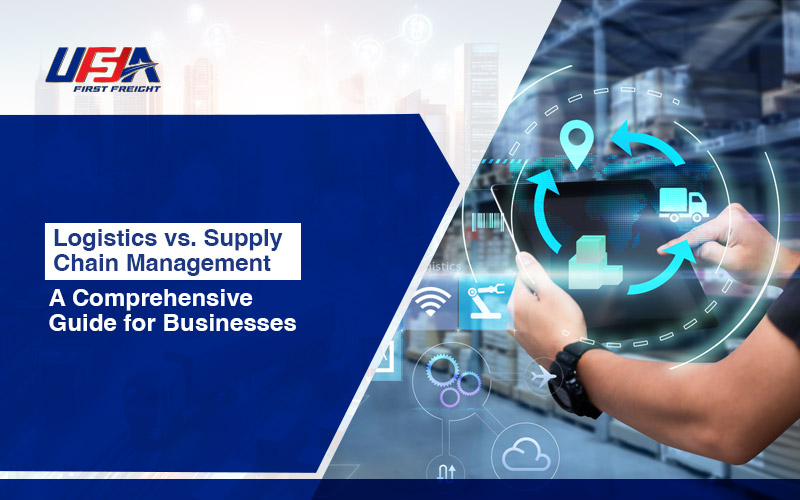In today’s fast-paced business world, many people refer to “logistics” and “supply chain management” in the same context. These are two different concepts that play important roles in a business, but what is the difference? Let us break down logistics vs. supply chain management and explain why knowing the difference is important for your business’s success.
What Is Logistics?
Logistics is the procedure of transferring and storing goods. In other words, logistics concerns moving products efficiently from one place to another. It involves everything from warehousing and transportation to order fulfilment and delivery, among others. Essentially, this means behind-the-scenes work to make sure that the product is in the right place at the right time.
Logistics management aims to make such processes as smooth and cost-effective as possible. It is about optimizing the flow of goods, managing inventory, and costs related to storage and shipping. Suppose a company is supposed to deliver a product to a customer within a specific time frame; then logistics management would be the function for making it happen without delay and at the least possible cost incurred.
What is Supply Chain Management?
Supply Chain Management (SCM) is a large term to grasp. SCM manages the entire supply chain, which facilitates goods from raw materials to final products until they reach the hands of the customer. Other than logistics, numerous functions include sourcing raw materials, managing suppliers, coordinating the manufacturers, and ensuring that all the people involved in the entire supply chain do not have issues with one another.
In some sense, supply chain management is about forming and maintaining relationships with suppliers, manufacturers, and logistics providers to ensure that goods are produced and delivered efficiently. It’s all about maximizing efficiency and creating value for customers through the on-time delivery of quality products at a reasonable cost.
Understanding how supply chain management works is essential for optimizing these processes and achieving long-term business success.
Key Differences Between Logistics and Supply Chain Management
To differentiate between logistics management and supply chain management, it’s helpful to break down some of the main areas where they differ:
- Scope of Operations: Logistics can be defined as the storage, movement, and transportation of goods in an organization. Supply chain management is a more inclusive term that refers to logistics but also includes sourcing, manufacturing, and supplier relationships.
- Goal and Purpose: Logistics management aims to deliver goods to customers at the point of demand at the right time and at the lowest possible cost. Meanwhile, the supply chain management process starts with raw materials and extends to the whole supply chain, which involves efficiently using all items in the production process.
- Functions and Activities: Logistics activities include warehouse, inventory control, order fulfilment, and transport. On the other hand, SCM encompasses logistics, procurement, supplier network collaboration, production planning, and customer relationship management.
- Internal vs. External Network Focus: Logistics management tends to focus inward within an organization, such as warehouse operations and delivery coordination and does not consider the inter-organizational relationships and networks inherent in supply chains. In contrast, supply chain management looks outward to suppliers, manufacturers, and distribution partners to optimize the entire supply chain of production and delivery.
- End-to-End vs. Part of the Process: Logistics is typically a supply chain process, mainly focusing on the tail end of delivering goods to the customer. Supply chain management, on the other hand, cuts across more of the business lifecycle from sourcing to delivery.
Why Logistics and SCM are Important to a Business
Both logistics and supply chain management are important to a business for proper running. Here is how both contribute to a running business:
Logistics: Logistics ensures that the product is delivered to the final mile on time for a firm’s competitive advantage. Proper logistics management will enhance delivery efficiency, cut costs, and ensure the best experience for customers in receiving the appropriate product in excellent conditions.
Supply Chain Management: It allows the development of a strong supplier and manufacturer network. This results in cost reduction, improved quality control, and easier responses to market shift changes. Supply chain management creates a more resilient business model by managing the entire chain from raw materials to finished goods.
In other words, logistics ensures that trains run on time, while supply chain management ensures that those trains are fully stocked, cost-effective, and reliable.
How Logistics and Supply Chain Management Work Together
It is essential to realize that these activities are integrated, though we have so far distinguished between logistics and supply chain management. Effective supply chain management relies on efficient logistics management and vice versa. If optimized, both can lead to competitiveness gains due to reduced costs and customer satisfaction.
For instance, a firm that gets the supply chain right, but logistics wrong would be more concerned with delayed shipments and dissatisfied customers. On the other hand, a firm that gets logistics right, but supply chain management wrong might have a problem with supplier reliability or high production costs. If logistics and supply chain management are merged, businesses can design a smooth process that benefits all stakeholders, suppliers, and customers.
Conclusion
Both logistics and supply chain management have strategic functions within a business entity. Logistics refers to matters like product movement and storage. On the other hand, supply chain management is wider because it includes the whole production and delivery chain. Modern supply chain management leverages advanced technologies and data analytics to enhance visibility, improve decision-making, and optimize the flow of goods from production to consumption.
These differences enlighten businesses about how they might engage more effectively toward cost-cutting and better servicing of customers. You will be able to build a robust and customer-focused operation to thrive in today’s market by investing in both areas.
